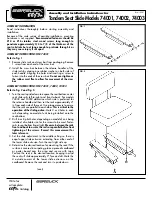
96
MG.30.A7.02 - VLT
®
is a registered Danfoss trademark
Parameter description
2.. References and limits
✮
= Factory setting. Text in ( ) = Display text.
The figures in [ ] are used in bus communication.
Value:
0.00 - 3600 sec.
The ramp-up time t
a
is the acceleration
time from 0 Hz to the rated motor fre-
quency, provided that the output current
is not higher than the current limit (para-
meter 209).
215
Ramp-up time
(Ramp up time)
✭
Depending
on unit
✭
Depending
on unit
225 (version 3.0)
Output frequency-
dependent switch
frequency
(output.sw.freq.)
Value:
✭
DISABLE
[0]
ENABLE
[1]
The switching frequency depends on the
output frequency. The switching frequency
can either be fixed at "DISABLE" or
decreasing with increasing output frequency
"ENABLE".
Maximum switch frequency is,
however, determined by parameter 224.
216
Ramp-down time
(Ramp down time)
The ramp-down time t
−
A
is the deceleration
time from rated motor frequency to 0 Hz,
provided that there is no excess voltage in
the inverter due to regenerative operation
of the motor. The requirement of rapid
braking can make it necessary to install a
brake option.
Value:
0.00 - 3600 sec.
✭
Depending
on unit
217
Alternative
ramp-up time
(ALT. up ramp)
Value:
0.00 - 3600 sec.
The alternative ramp time is activated
using start on jog speed via terminal 29,
parameter 405.
A start signal must
not have been given
(e.g. terminal 18, parameter 402).
✭
Depending
on unit
218
Alternative
ramp-down time
(ALT. down ramp)
Value:
0.00 - 3600 sec.
The alternative ramp time is activated using
quick stop via terminal 27,
parameter 404
or via serial bus (RS485).
219
Frequency bypass 1
(Freq 1 bypass)
220
Frequency bypass 2
(Freq 2 bypass)
221
Frequency bypass 3
(Freq 3 bypass)
222
Frequency bypass 4
(Freq 4 bypass)
223
Frequency bypass
band width
(Bypass B. width)
Value:
0 - f
RANGE
✭
f
RANGE
Value:
0 - f
RANGE
✭
f
RANGE
Value:
0 - f
RANGE
✭
f
RANGE
Value:
0 - f
RANGE
✭
f
RANGE
Value:
0 - 100%
✭
0
Some systems require that certain output
frequencies are avoided due to resonance
problems in the installation.
Record the frequencies to be avoided and
record the bandwidth as a percentage of
the recorded frequencies.
The bypass
band is the bypass fre/- the set
bandwidth.
224
Carrier frequency
(Carrier freq.)
Value:
2.0 - 14.0 kHz
✭
4.5 kHz
The set value determines the carrier fre-
quency. Changing the switching frequency
will minimise any acoustic noise from the
motor.
VLT
®
3060-3250 and certain old
types may not operate at a higher switching
frequency than 4.5 kHz.
Note: Switching frequencies higher than
4.5 kHz give certain deratings, see p. 131.
Artisan Technology Group - Quality Instrumentation ... Guaranteed | (888) 88-SOURCE | www.artisantg.com
















































